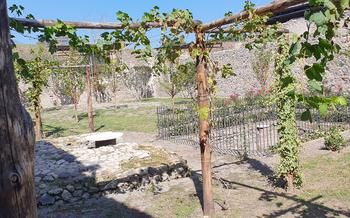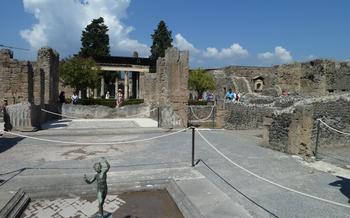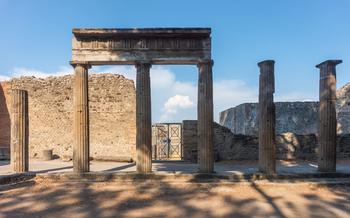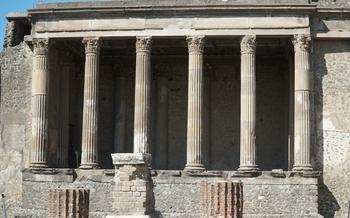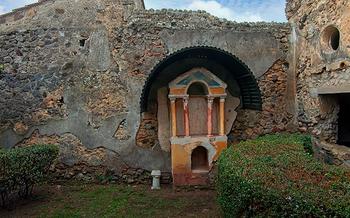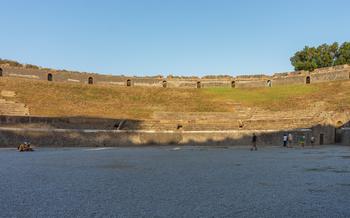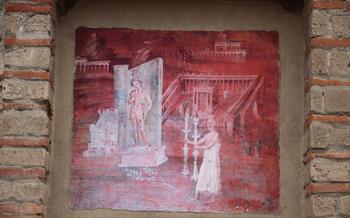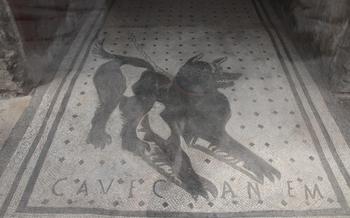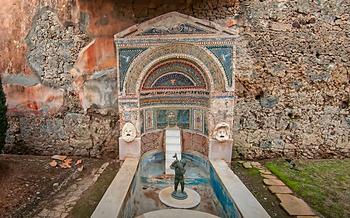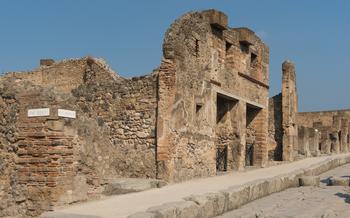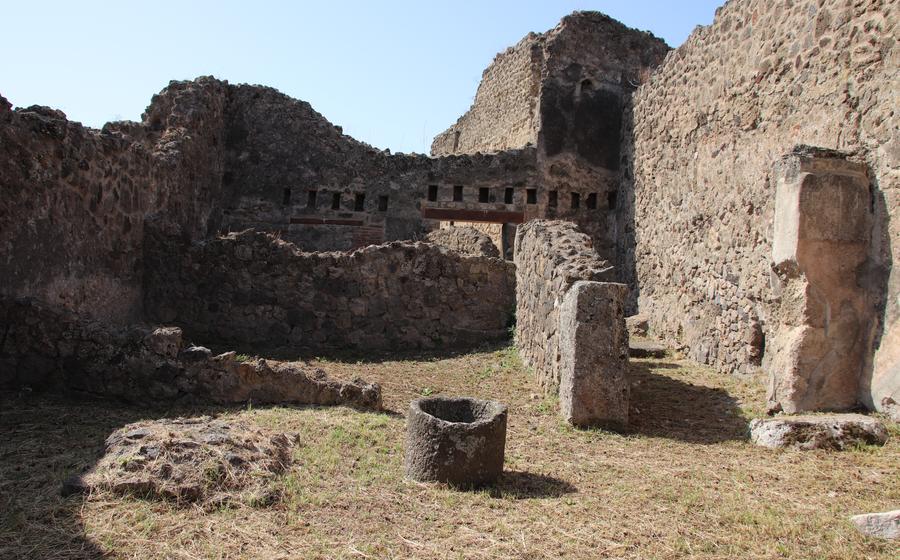
House of the Baker
- Introduction - The Allure of Pompeii's Ancient Bakery
- Delving into the History of the House of the Baker
- A Glimpse into the Daily Life of a Roman Baker
- Exploring the Well-Preserved Bakery Structure
- Uncovering Ancient Artifacts and Treasures
- The Story of the Oven
- Bread as a Staple in the Roman Diet
- The Bakery's Connection to the Eruption
- Preservation Efforts and Ongoing Research
- Visiting the House of the Baker Today
- Imagining the Bustling Atmosphere of the Bakery
- Reflecting on the Resilience of Pompeii's People
- Connecting with History Through the Bakery
- Inspiring Culinary Curiosity
- Insider Tip - Capture the Magic of the Bakery:
Introduction - The Allure of Pompeii's Ancient Bakery
Pompeii, the ancient Roman city immortalized by the catastrophic eruption of Mount Vesuvius, offers an intriguing glimpse into the daily lives of its inhabitants. Amid the ruins of this once-bustling metropolis, the House of the Baker stands as a testament to the resilience and ingenuity of Pompeians.
Located in the heart of the archaeological park, just steps away from the bustling Via dell'Abbondanza, the bakery offers a unique opportunity to step back in time and witness the inner workings of a thriving Roman business. Prepare to be transported to a world where the aroma of freshly baked bread permeated the air, and the clatter of ovens and the bustle of bakers created a vibrant symphony of everyday life.
Delving into the History of the House of the Baker
The House of the Baker, nestled amidst the ruins of Pompeii, offers a captivating glimpse into the life of a Roman baker and the significance of bread in ancient Roman society. The bakery belonged to a man named Modestus, who skillfully crafted loaves of bread that sustained the community.
Modestus's bakery was tragically preserved during the catastrophic eruption of Mount Vesuvius in 79 AD. The volcanic ash, which engulfed and buried the city, acted as a time capsule, preserving the bakery's structure, equipment, and artifacts. This remarkable preservation allows us to connect with the daily life of a Roman baker and gain insights into the ancient Roman economy.
The House of the Baker stands as a testament to the interconnectedness of daily life and economic activity in ancient Pompeii. The bakery not only provided sustenance to the local population but also contributed to the broader economic system of the Roman Empire.
A Glimpse into the Daily Life of a Roman Baker
The House of the Baker provides a unique window into the daily life of a Roman baker. The bakery was a bustling hub of activity, where skilled bakers worked tirelessly to produce bread for the city's population. The process began with the grinding of wheat into flour using millstones. The flour was then mixed with water and yeast to form dough, which was kneaded and left to rise. Once the dough had risen, it was shaped into loaves and placed in the oven to bake.
The ovens were a crucial part of the baking process. They were typically made of brick or stone and heated with wood or charcoal. The bakers carefully controlled the temperature of the ovens to ensure that the bread baked evenly and had a golden-brown crust. The bread produced in the House of the Baker was a staple food for the Romans. It was eaten at all meals and was often accompanied by olive oil, cheese, or vegetables. Bread also played a significant role in religious ceremonies and festivals.
Exploring the Well-Preserved Bakery Structure
The House of the Baker in Pompeii offers a remarkably well-preserved glimpse into the daily life of a Roman baker. The bakery's layout is clearly visible, with various rooms dedicated to different stages of the bread-making process. The main room, where the bread was baked, features a large oven, millstones for grinding grain, and work surfaces for kneading dough. Other rooms served as storage areas for flour, water, and finished bread.
The bakery's machinery and equipment provide valuable insights into the techniques used by Roman bakers. The millstones, made of volcanic rock, were used to grind wheat into flour. The oven, constructed of clay and brick, was heated with wood or charcoal and could reach temperatures of up to 450 degrees Celsius. The bakery also features a number of smaller ovens, used for baking different types of bread or for keeping food warm.
The architectural design of the bakery reflects the importance of bread in Roman society. The bakery is located in a central area of Pompeii, near the city's main square. It is a substantial building, with sturdy walls and a tiled roof. The oven is placed in a prominent position, visible from the street, indicating the baker's status as a respected member of the community.
Uncovering Ancient Artifacts and Treasures
Within the House of the Baker, visitors can discover a treasure trove of well-preserved artifacts that provide invaluable insights into the daily lives and culinary practices of the ancient Romans. The most prominent artifacts are the millstones, which were used to grind wheat and other grains into flour. These millstones, often made of lava stone, were operated by hand or by donkeys and played a crucial role in the production of bread.
In addition to the millstones, the bakery also housed various ovens used for baking bread. These ovens, made of clay or brick, were designed to retain heat and distribute it evenly, ensuring that the bread was cooked thoroughly. The ovens also feature intricate designs and decorations, revealing the artistic skills of the Roman craftsmen.
Furthermore, the bakery yielded a rich collection of household objects, including pots, pans, and utensils used in the bread-making process. These objects provide tangible evidence of the daily activities that took place within the bakery, shedding light on the routines and practices of the Roman bakers.
The significance of these artifacts extends beyond their individual value. They collectively contribute to our understanding of Roman life, offering a glimpse into the economic, social, and cultural aspects of ancient Roman society. By examining these artifacts, we can piece together the story of the House of the Baker and gain a deeper appreciation for the ingenuity and resilience of the people who lived and worked in Pompeii.
The Story of the Oven
At the heart of the House of the Baker, the oven stands as a testament to the ingenuity and skill of Roman bakers. Constructed from sturdy materials, the oven was designed to withstand the rigors of daily use. Its domed shape helped to distribute heat evenly, ensuring that bread was cooked thoroughly. The oven's interior was lined with fire-resistant bricks, which retained heat and allowed for precise temperature control.
Using a combination of wood and charcoal as fuel, the baker would carefully regulate the temperature of the oven. The intense heat created within the oven's chamber transformed the dough into golden-brown loaves of bread. The baker's expertise was evident in the way he controlled the temperature and monitored the baking process, resulting in bread that was both flavorful and nutritious.
Besides serving as a tool for baking, the oven also held a significant role in the community. It was a gathering place where people would come together to socialize and exchange news. The baker, a respected member of the community, would often engage in conversation with his customers, creating a sense of camaraderie and fostering a sense of belonging among the residents of Pompeii.
Bread as a Staple in the Roman Diet
For the Romans, bread was more than just sustenance; it was a fundamental component of their daily life and an essential part of their diet. Roman bakers produced a wide array of bread varieties, crafted from different types of flour, including wheat, barley, and spelt. Flatbreads, known as "focaccia," were a popular choice, made by rolling out the dough and baking it on hot stones or in ovens.
Bread played a crucial role in Roman cuisine, serving as a staple accompaniment to various dishes. It was often consumed alongside stews, vegetables, and cheeses, providing a hearty and filling base. The Romans also had a penchant for using bread as a utensil, employing it to scoop up sauces and other liquid components of their meals.
The significance of bread in Roman society cannot be understated. It was not only a vital source of nourishment but also held cultural and religious importance. Bread was often offered as a sacred offering to the gods, and its distribution among the populace was a common practice during festivals and celebrations.
The Bakery's Connection to the Eruption
The catastrophic eruption of Mount Vesuvius in 79 AD sealed the fate of Pompeii and its inhabitants, including the House of the Baker. The bakery, once a symbol of sustenance and daily life, bore witness to the cataclysmic event that forever changed the city.
As the volcanic ash and pumice rained down, the bakery was engulfed in a thick blanket of debris. The oven, once a source of warmth and nourishment, was extinguished, its last loaves of bread left to char within its depths. The tools and artifacts, once meticulously used by the baker, were buried under layers of ash and pumice, preserved as poignant remnants of a thriving trade.
The destruction of the bakery epitomizes the sudden and devastating impact of the eruption. The once-bustling establishment, filled with the aroma of fresh bread and the sounds of daily labor, was reduced to a silent and desolate ruin. It stands as a testament to the fragility of human endeavors in the face of nature's wrath.
Preservation Efforts and Ongoing Research
Despite the ravages of time and the catastrophic eruption, the House of the Baker has withstood the test of centuries, thanks to meticulous preservation efforts. Archaeological excavations have carefully uncovered more artifacts, providing valuable insights into the daily lives of the ancient Romans. Ongoing studies continue to shed light on the bakery's significance within the Roman economy and its role in shaping the culinary landscape of the ancient world. Through these dedicated efforts, we gain a deeper appreciation for the resilience and ingenuity of the Pompeian people.
Visiting the House of the Baker Today
The House of the Baker is easily accessible within the Pompeii ruins, located just a short walk from the main entrance. Guided tours are available and highly recommended for a comprehensive experience. Knowledgeable guides will share fascinating insights into the history and significance of the bakery, bringing its story to life. Plan your visit to coincide with the early morning or late afternoon hours to avoid crowds and fully immerse yourself in the tranquility of the ruins. Take your time to explore the bakery's nooks and crannies, imagining the hustle and bustle of ancient bakers producing bread for the community.
Imagining the Bustling Atmosphere of the Bakery
Close your eyes and transport yourself back in time to the thriving city of Pompeii. Step into the House of the Baker and witness the bustling activity that once filled this space. Observe the baker, his hands deftly shaping the dough, skillfully maneuvering it into the glowing oven. Listen to the rhythmic grinding of grain and the rhythmic kneading of the dough, a symphony of sounds that echoes through the bakery. Inhale deeply, savoring the tantalizing aroma of freshly baked bread wafting through the air, a delectable reminder of the bakery's purpose.
Reflecting on the Resilience of Pompeii's People
As you stand amidst the ruins of the House of the Baker, take a moment to reflect on the resilience and indomitable spirit of Pompeii's people. This bakery, once a bustling hub of daily life, now stands as a testament to their perseverance in the face of adversity. Its remarkably preserved structure serves as a reminder of the vibrant community that thrived here, even in the shadow of Mount Vesuvius.
Imagine the bakers, tirelessly tending to the oven, their hands deftly kneading the dough, their faces illuminated by the flickering flames. The aroma of freshly baked bread would have wafted through the streets, beckoning customers to savor its deliciousness. Despite the constant threat of volcanic eruption, the people of Pompeii carried on with their lives, resilient and unyielding.
The bakery's survival, albeit in ruins, stands as a symbol of their indomitable spirit. Even as the catastrophic eruption buried the city under layers of ash and pumice, the legacy of the House of the Baker lived on, a testament to the resilience of the human spirit.
Connecting with History Through the Bakery
As you stand within the ruins of the House of the Baker, let your senses transport you back in time. Reach out and touch the ancient oven, worn smooth by centuries of use. Imagine the baker's hands, deftly shaping the dough, his sweat and determination mingling with the rising heat. Touch the millstones, their rough surfaces a testament to the tireless grinding of grain. Hear the distant echo of voices, the laughter and conversations of people long gone. Feel the weight of history in your hands, connecting you to the lives that once thrived within these walls.
Imagine the aromas that filled the air—the yeasty tang of fresh bread, the smoky scent of the oven, the earthy fragrance of flour. Picture the baker's family gathered around the table, breaking bread together, their faces lit by the warm glow of the hearth. Sense the pride and satisfaction the baker felt, knowing that his work was nourishing his community. By connecting with the physical remains of this ancient bakery, you are not merely visiting a ruin—you are stepping into the lives of the people who lived here, sharing their struggles, their joys, and their resilience.
Inspiring Culinary Curiosity
The House of the Baker provides an exceptional opportunity to delve into the culinary traditions of ancient Rome. Take the opportunity to explore nearby restaurants that serve authentic Roman bread, savoring the flavors that have stood the test of time. Consider enrolling in a cooking class to learn the art of making your own Roman bread, using techniques that have been passed down through generations. Discover the profound influence of Roman bread-making techniques on modern baking practices, tracing the lineage of contemporary breads to their ancient roots.
Insider Tip - Capture the Magic of the Bakery:
To truly appreciate the essence of the House of the Baker, visit during the early morning or late afternoon when the crowds are fewer. This will allow you to soak in the tranquility of the ruins and fully immerse yourself in the atmosphere of ancient Pompeii. Take your time to explore the bakery, imagining the hustle and bustle of daily life as the baker worked diligently in the oven. Listen to the grinding of the grain, the kneading of the dough, and the crackling of the fire. Smell the fresh bread filling the air, a reminder of the bakery's enduring legacy. By visiting during these quieter hours, you'll have the opportunity to connect with the past on a deeper level and capture the true magic of the House of the Baker.
